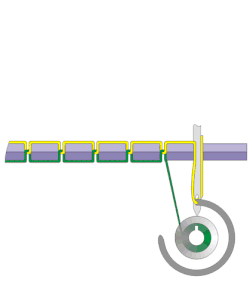These are the imaginary lines made to plot the earth on two dimensional coordinate system. In two dimensional coordinate system the horizontal axis is called as x-axis and vertical axis in known as y-axis. So the earth's x-axis or horizontal axis is called equator. The vertical axis or y-axis is called as Prime Meridian is at Greenwich, England.
But unlike the coordinate system whose axes tends to infinite, the earths axes are finite and are measured in degrees, minutes and seconds. The longitude is measured as 180 deg.on right side of y-axis called 180 deg East and 180 deg on left side is called as 180 deg. West.
LATITUDES LONGITUDES


Similarly the latitudes is measured as 90 deg North above the x-axis or equator and 90 deg South below the equator.
Why we demarcate the Earth?It is similar to locate a point on a coordinate system. With the measurement of latitude and longitude we can locate any place on the Earth. Suppose we want to know where 'Delhi' is located. If the answer is
"Delhi has a longitude of 77 deg 13'E and latitude of 28 deg 39'N".
It means that on East side that is right side on Prime Meridian by 77 deg 13' and North side of equator by 28 deg 39'.
 Where these angles are formed as we measure in degrees?
Where these angles are formed as we measure in degrees?
Imagine the Earth was a
transparent sphere (actually the shape is slightly oval; because of the Earth's rotation, its equator bulges out a little). Through the transparent Earth (drawing) we can see its equatorial plane, and its middle the point is O, the center of the Earth.
To specify the latitude of some point P on the surface, draw the radius OP to that point. Then the elevation angle of that point above the equator is its latitude λ--northern latitude if north of the equator, southern (or negative) latitude if south of it.
| Every meridian must cross the equator. Since the equator is a circle, we can divide it--like any circle--into 360 degrees, and the longitude φ of a point is then the marked value of that division where its meridian meets the equator. |
| ![[IMAGE: lines of longitude]](http://www-istp.gsfc.nasa.gov/stargaze/Sfigs/Slonglne.gif) | Longitude
lines or "meridians" |
|
What that value is depends of course on where we begin to count--on where
zero longitude is. For historical reasons, the meridian passing the old Royal Astronomical Observatory in Greenwich, England, is the one chosen as zero longitude. Located at the eastern edge of London, the British capital, the observatory is now a public museum and a brass band stretching across its yard marks the "prime meridian."







![[IMAGE: lines of longitude]](http://www-istp.gsfc.nasa.gov/stargaze/Sfigs/Slonglne.gif)